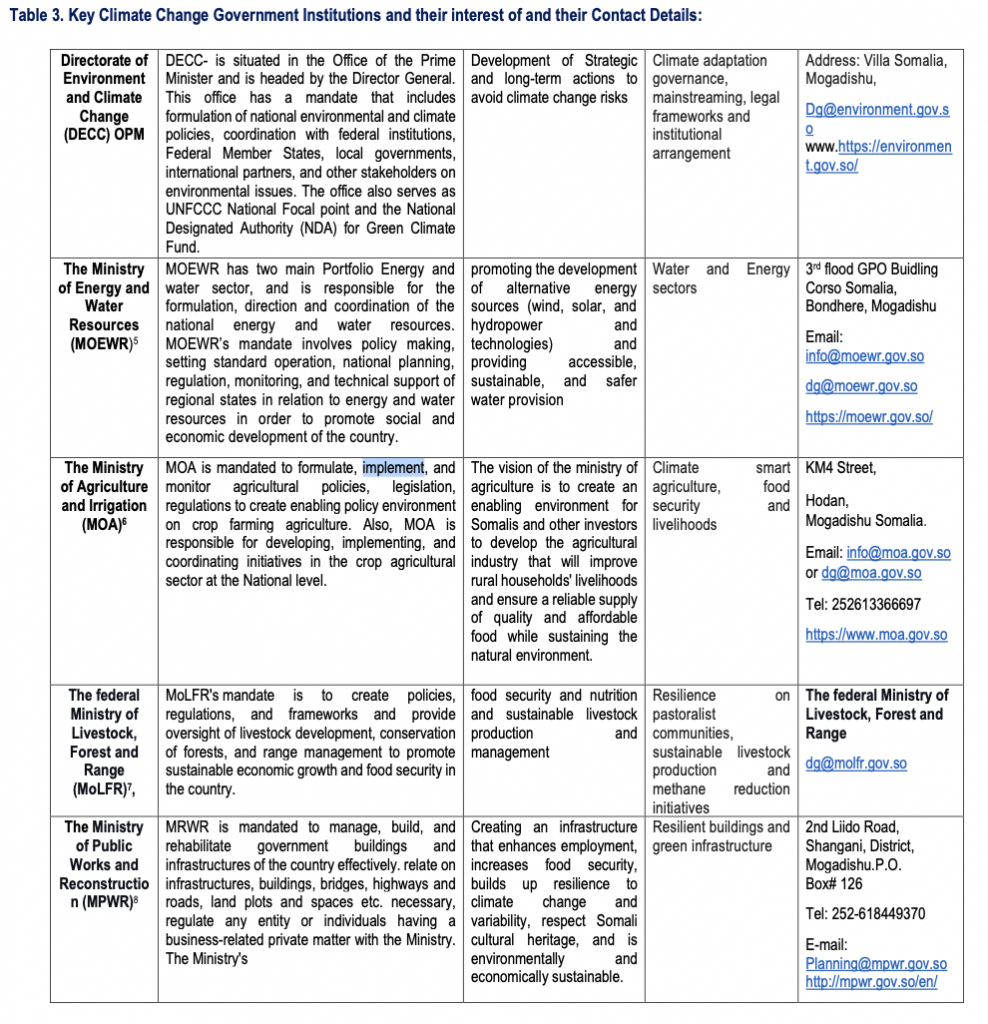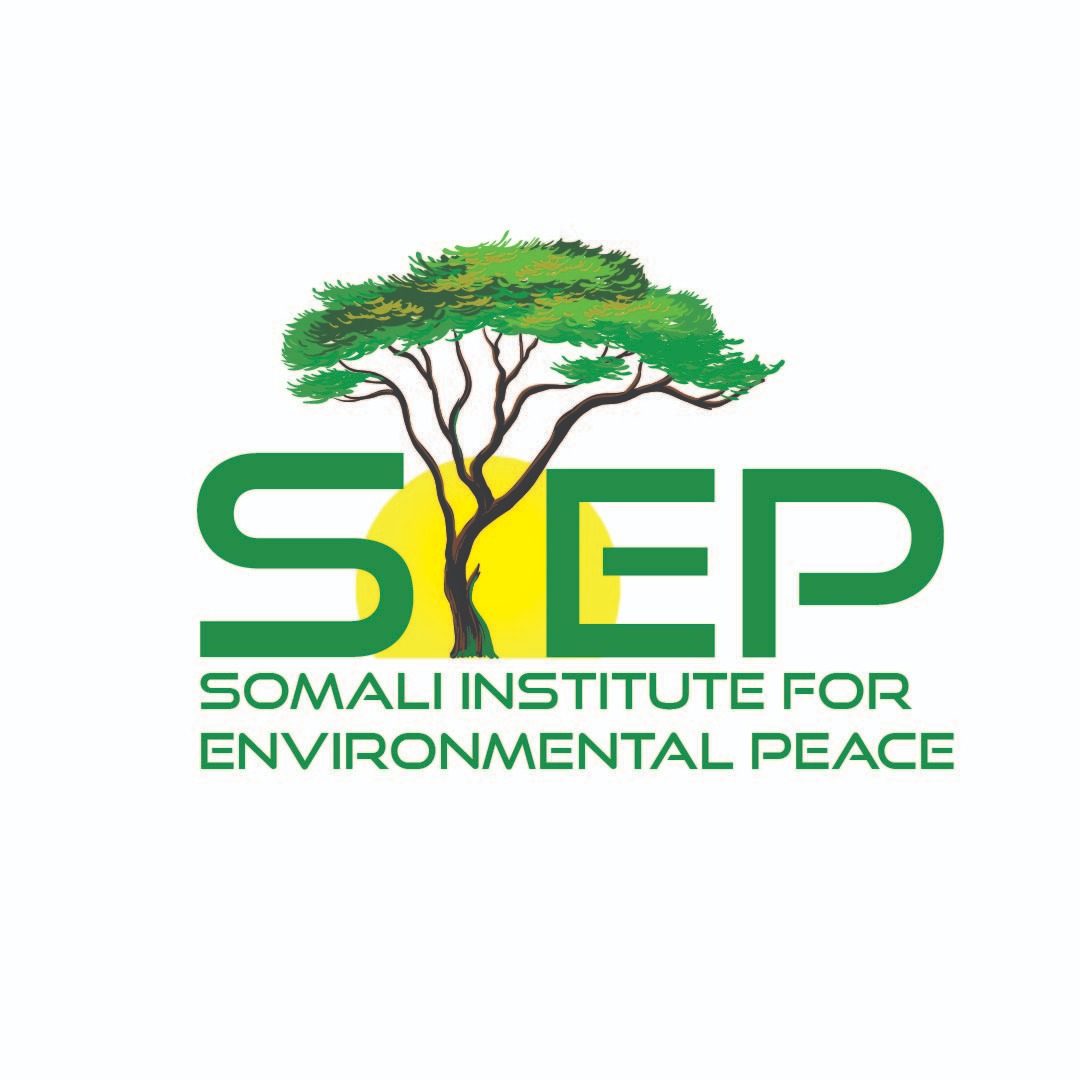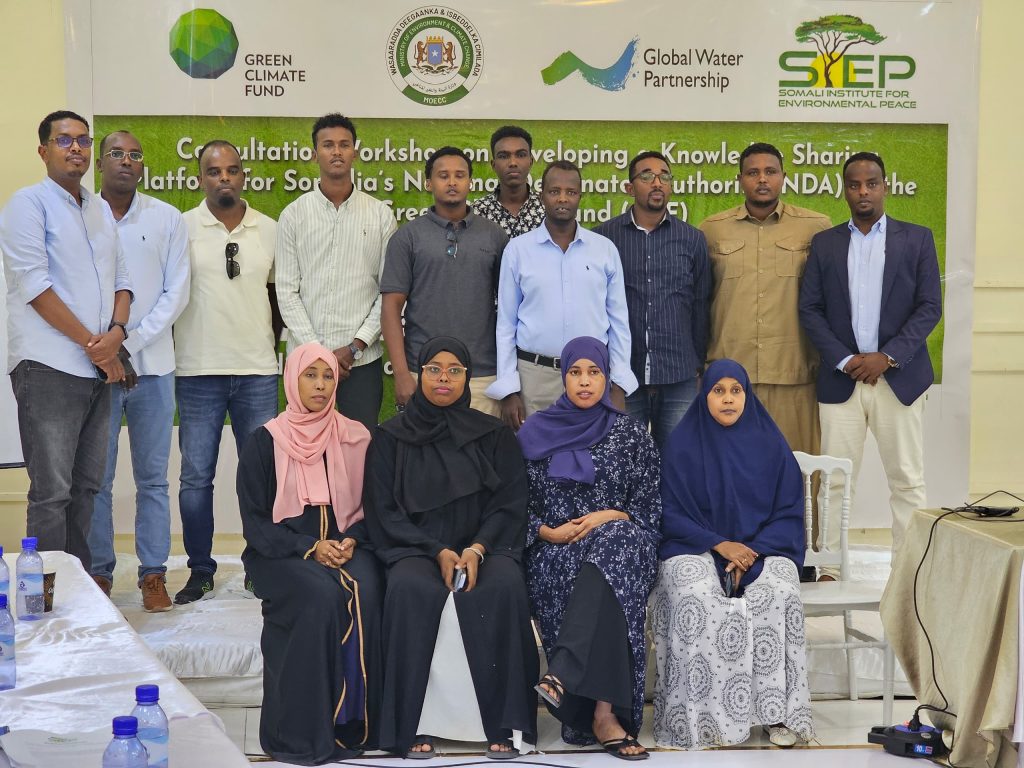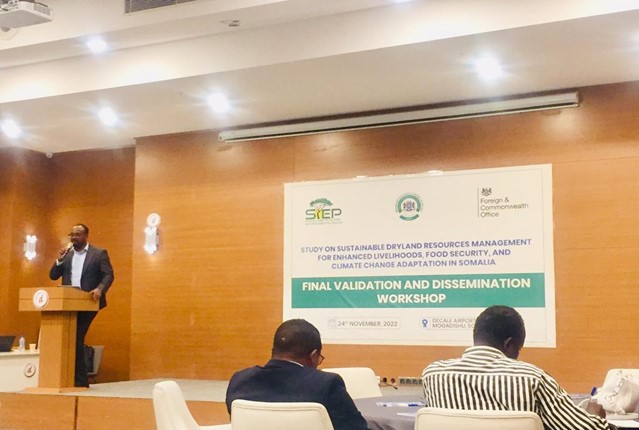
Executive Summary
This report aims to map, identify, and learn about the various climate change actors’ roles in Somalia’s climate change actions and interventions. The following critical steps were designed to undertake stakeholder mapping: identifying stakeholders, categorizing, analysing and prioritizing their interest in climate change. The findings indicated that stakeholders were unanimous in that the existing coordination mechanisms among the country’s climate stakeholders was inadequate to meet the needs of the climate change actors in Somalia. The government has limited ability to develop policies, enforce them, and manage the limited public budget. Furthermore, because the Federal and state level institutions are nascent, the institutional set-up, arrangement, and capacities required to address the adverse impacts of climate change are yet to be put in place. In a context of lack of resources, political divisions, and absence of solid coordination mechanisms and understanding of the total value of the environment and the challenges posed by climate change, amongst other things, continue to hinder efforts to overcome environmental and climate challenges. The report found that the mainstreaming of climate action plans and commitments are not effectively done in the country, and most of the interventions are project-driven initiatives and interventions. Stakeholders recognized that even though climate change is everyone’s responsibility, they still believe that there exists considerable room and opportunity for the government to do more than what it has managed to achieve so far. Areas such as climate strategy development, awareness-raising, capacity development, planning, coordination, and financing of climate change initiatives that remain in the government’s domain need more commitment. Finally, as far as the objectives of this report are concerned, SIEP and DECC-OPM should work together to support the development of a climate actors database based on this stakeholder report at the DECC. This database will facilitate information, communication and networking of climate change actors and stakeholders to feed into the national coordination mechanism.
Chapter One: Introduction
1.1. Background and context
Climate change poses a significant threat to the development of Somalia due to over-dependence on agriculture, livestock production, water, and forestry resources which are very susceptible to weather and climate variations. Livestock and agriculture account for 70% of the livelihood base. Somalia is considered a Least Developed Country with 69% of the population living below the poverty line1. (With the collapse of the state and governance structures in 1991, Its natural resources have faced massive environmental degradation due to lack of environmental protection, conservation, and enforcement mechanisms leading to the emergence of unsustainable activities such as the illegal charcoal trade, illegal fishing among others. These coupled with climate change continues to undermine efforts toward sustainable management of Somalia’s natural resources. Women and children especially in rural areas are the most vulnerable groups to climate change in Somalia.
Recently, Somalia has experienced relative stability leading to the establishment of critical institutions including these related to climate change and natural resource governance. The Directorate of Environment and Climate Change (DECC), Office of the Prime Minister, is responsible for managing, coordinating, and supervising all matters relating to the environment and climate change in Somalia. DECC continues to play a critical role in putting in place policies and legislative frameworks for addressing climate change in the country.
The government of Somalia has made notable efforts towards addressing the threat posed by climate change by enacting climate change-related policies including the development of Somalia National Climate Change Policy 2020 aimed at enhancing resilience and improve the adaptive capacity of vulnerable Somali communities, the ecosystems on which they depend, to the adverse impacts of climate change. The Somalia National Climate Change Policy 2020 is crucial to the implementation and achievement of the Sustainable Development Goals (SDGs, 2015) and the National Development Plan 2020 -2024.
Although a lot of efforts have been put in place to address climate change, the effective stakeholder engagement and their coordination remains to be among the significant challenges facing the climate change action in Somalia.
The absence of clear and systematic planning for long-term climate change actions through the broad- based climate change stakeholders and lack of mainstreaming such into national, sectoral, or subnational budgeting or planning policies represents a major gap for policy development, resource mobilization, and financing of adaptation and mitigation actions for the country2.
1 National Development Plan, 2017
2 National Climate Change Policy 2020
1.2. Stakeholder Mapping Rationale
At the national level, the Directorate of Environment and Climate is the national institution mandated to protect the environment and implement climate change actions. Similarly, each of the federal member state have state environment ministries working in their respective states. On the other hand, there are non-governmental actors working in the environment and climate change sector dispersed across the country. At the moment, there is no database or even a list of the nongovernmental organizations. This means, weak engagement and partnership between the government institutions on the one hand and non-governmental organizations on the other. The government institutions do not have data or information about the actors, their capacity, mandates and who is doing what.
It is against this background and in response to the Government of the Federal Republic of Somalia’s request that this technical support under the Climate Diplomacy Fund is a new centrally-managed UK government fund to build the conditions for an ambitious negotiated outcome at COP26 and deliver Country Implementation Plans and implemented by the Foreign, Commonwealth & Development Office (FCDO). Somalia’s government aims to identify and strengthen the coordination mechanism of all key actors working in the climate change sector at national and sub-national levels, their capacities, mandates, and core activities. Also, it will propose technical recommendations on the best ways to engage with them in the country’s climate change actions.
Through this assignment, the mission was able to identify and gather stakeholders in order to strengthen the country’s climate actions. The process of mapping stakeholders had the goal of answering the following questions and supported the task teams to identify the key climate change actors in the country (Federal or FMS), their relationships, and their drivers and obstacles in order to better involve stakeholders and foster and strengthen stakeholder’s coordination and collaborations.
At the end of this assignment, stakeholder mapping report was produced which will serve as a reference for the government institutions as well as international partners interested in the climate change and environment sector in Somalia.
1.3. Objectives
The purpose of this assignment was to conduct an in-depth analysis of stakeholders or actors working in the climate change and environment sector in Somalia. The aim is to identify the main actors so that the Directorate of Environment and Climate Change, the national environmental institution, can have a more effective engagement and partnership with non-governmental organizations working in the environment and climate change actions. Therefore, stakeholder mapping will enhance partnerships among the actors and the Directorate and among the actors themselves, thereby enhancing engagement, capacity building, knowledge and skills sharing to better protect the environment and adapt to climate change.
The overall objective is to carryout Stakeholder Mapping exercise that will enable to identify the primary and secondary stakeholders of the country’s climate actions and as well promote the participation of stakeholders in the development and implementation of the key country climate policies, plans and projects.
Chapter Two: Methodology
2.1. Overview
This report is a combination of both desk study and analysis of field data collected in electronic ways. The deskwork included a literature review that was carried out to attain a general understanding of climate change and its impacts in the country and get an idea of the adaptation and mitigation measures taken by the government and a range of stakeholders. The literature review further helped in identifying potential actors to be contacted during the report preparations.
With the support of the Directorate of Environment and Climate Change, the consultant reviewed existing reports and literature and contacted key stakeholders to identify and agree on the primary stakeholders in the field of Climate Change Adaptation and Mitigation in the country. Initial communications and discussions were held with team to lay down the groundwork for communications and collecting the required data on Climate Chane actors in the country. The main focus of the report lies in identifying potential climate change-interested stakeholders.
The primary respondents included government ministries, departments, and agencies; Local government authorities; Development partners; Research and academic institutions; Non-governmental organizations (local and international); and civil society organizations. Where possible, contact persons were identified to facilitate the dissemination of questionnaires and data collection. The challenging part of this report was face-face was impossible because of the covid-19 pandemic and time frame, and stakeholders were contacted through email and telephone.
2.2. Data collection
Questionnaires were used as primary tools for data collection. For the dissemination, the questionnaire’s online link and copy of the invitation letter from the SIEP email were sent to all primary respondents. In order to make sure that the questionnaires reached their destination, respondents were asked to confirm receipt and observe the deadline for submission for the filled-in questionnaires. The consultant contacted and sent a gentle reminder emails to the potential respondents regularly to ensure they responded quickly. After that, 83 representatives of the key stakeholders participated in the electronic questionnaires from 15 March to 29 March 2021. Each stakeholder representative was asked to fill the electronic and word questionnaires about its type of his/her organization, areas of focus or interventions/activities, resources, engaging coordination networks (attached the instrument Questionnaire).
Due to very short notes of the stakeholder’s participation and covid-19 pandemic and holidays for some active representatives, about 45% of respondents were provided feedback about the Questionnaires shared.
And finally, the key informant interviews structured questions were also prepared to complement and generate more in-depth information, mainly with the key stakeholders. However, the success rate was too low, especially with the government officials. This could be attributed to the ongoing political and election campaigns. The major limitations faced during the stakeholder mapping exercise were that the time available to carry out this mapping exercise and a validation process involving numerous
stakeholders was very limited. Moreover, some targeted mapping exercise participants were hesitant to take part in the study.
The significant limitations faced during ring the stakeholder mapping exercise was that the time available to carry out this mapping exercise and a validation process involving numerous stakeholders was minimal. Moreover, some targeted mapping exercise participants were hesitant to take part in the study.
2.3. Data Analysis
Upon concluding the data collection exercise, the data has been cleaned and validated, followed by consolidation and cross-tabulation. This survey was simple and covered only a small number of respondents; conclusions and recommendations were drawn directly from raw data and excel statistical analysis.
Chapter Three: Findings and Analysis
Stakeholder mapping is a tool that support understand the key stakeholders involved, their level of interest and influence as far as climate change actions are concerned. For the tool to remain relevant to the assessment, the exercise was made through a collaborative process and exercise by using multiple sources to identify stakeholders involved in the climate change actions in Somalia. The following critical steps were followed during the stakeholder mapping exercise which includes identification of stakeholders and categorization, analysis and prioritization of climate change stakeholders.
3.1. Climate Change Stakeholder Identification
to identify the key relevant climate change stakeholders. The first step in this process thus was to develop a list of main categories (groups) that may be working in areas related to climate change and related areas of interest. The list
included the main actors such as the
Initially, the mapping focused on identifying relevant actors with formal roles and responsibilities for managing climate change related actions and interventions (informal roles were to be captured during the stakeholder electronic contacts). To do this, a snowball sampling approach was used in which various types of empirical material were examined, including documents that directly identified potential stakeholder types, such as the national climate change policy (2020) the Nationally Determined Contributions (2021), Resilience and Recovery Framework (2019), Drought Impact and Needs Assessment (2018), state of environment report among others. But it should be noted that; this list should not remain static and will be updated as per the needs and time.
Table 1. Climate Change stakeholder identification
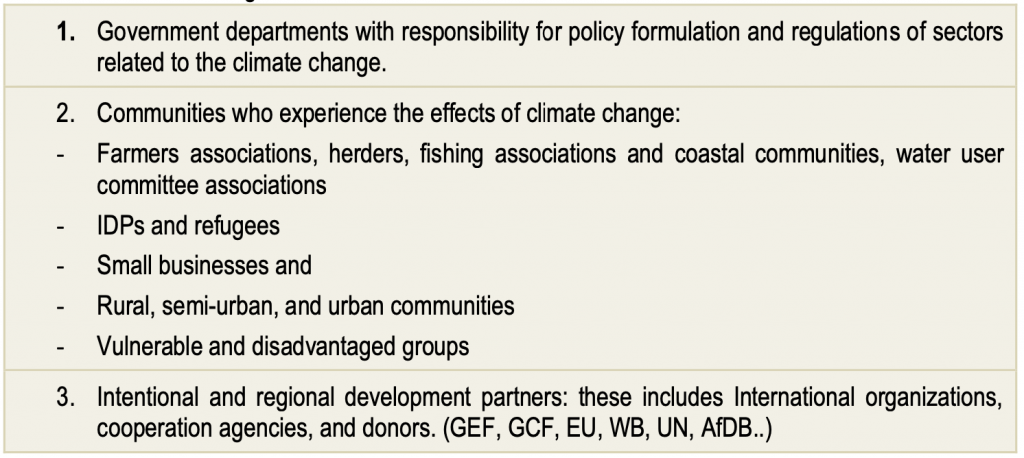

3.2.Climate Change Stakeholder Analyses
Table 2. Stakeholder Analysis Matrix:
Once the generic list of stakeholders was identified, it is helpful to do further analysis to better understand
their relevance and the perspective they offer, understand their relationship, and contribute to the
country’s national climate change action and to prioritize based on their relative importance matter.



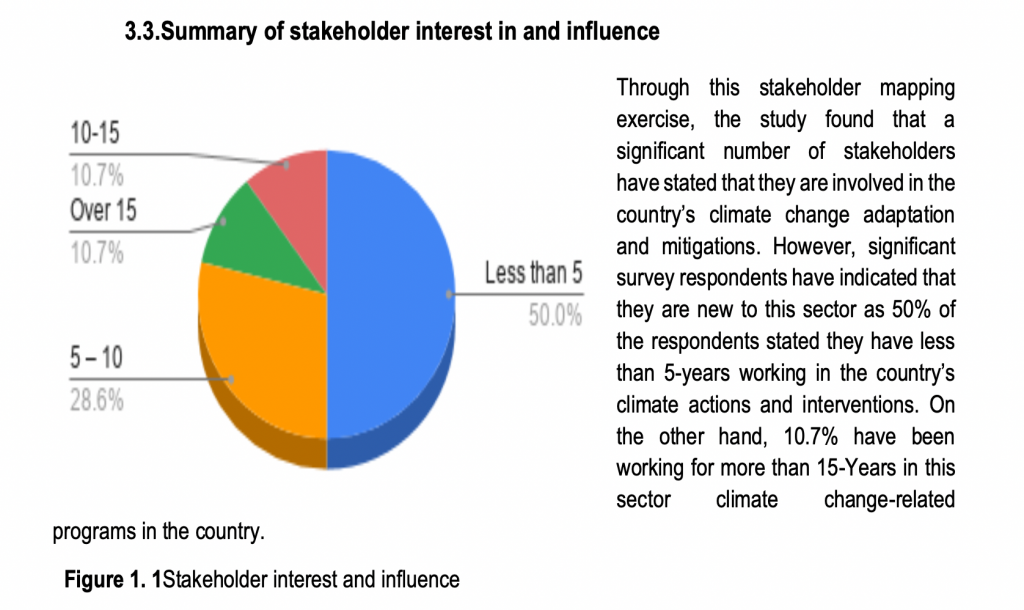
It is generally noted that Somalia Climate Change sector has multiple stakeholders with varying, sometimes conflicting visions and interests with unclear roles and responsibilities, and interests. These stakeholder groups also have different capacities for human, technical, financial, and political power. To involve all stakeholder groups in climate change activities, there is a need to understand their strengths and/or weaknesses. These different groups with various interests need different messages, tools, and approaches for them to be involved.
The situation is made more complex by weak governance systems, weak adaptive capacities, very poor communication and coordination among most of these different stakeholder groups, which sometimes takes informal correspondences. Such a situation may adversely affect any potential actions for adaptation to climate change and may resulted mal-adaptations. Moreover, it was noted that various stakeholders have limited knowledge and capacity on climate change impacts, vulnerability, and adaptation.
The following are among the key identified climate change stakeholders and actors
3.3.1 The Climate Affected Parties (The Communities)
Climate-affected communities or parties includes those affected or are likely to be affected by the adverse impacts of the climate change either actual impacts or potential risks to their physical environment, health, security, cultural practices, well-being, or livelihood. Climate affected parties include local communities, community members and other parties that may be subject to direct impacts from the national climate change actions, which includes impact on land, land-based livelihood, access, assets, and businesses
their relevance and the perspective they offer, understand their relationship, and contribute to the to better understand
country’s national climate change action and to prioritize based on their relative importance matter.
communities in both urban, semi-urban and rural areas. Community association such as herders, farmers, fishing communities, traditional and cultural elders among others are also responsible to make strategic decisions on behalf of their communities and ecosystems.
The study also found that; the disadvantaged / vulnerable individuals or groups are potentially disproportionally affected and less able to benefit from opportunities offered by the country climate actions due to specific difficulties to access and/or understand information about the adverse impacts of climate change. Internally Displaced People (IDPs), persons with disabilities, orphans, and elderly with no means of living and households with disabled members are the ones hugely affected by the climate change related extreme events with no or very limited social protection mechanisms and effective inclusive service delivery.
3.3.2 The Federal Climate Change Institutions
Somalia has recently experienced relative stability, which has led to the rebirth of its essential institutions, including those related to climate change and the governance of natural resources. The country has reinstated environmental and climate change governance structures and institutions, renewed dialogue with development partners and the international community, and adopted policies and legal frameworks.
The Directorate of the Environment and Climate Change (“DoECC”) has been formed within the Office of the Prime Minister. Since its formation the Directorate developed national environmental policy, national climate change policy, national determinant contribution of UNFCCC other regulations and legislations including the establishment of the Environmental Quality Standards, Sectoral Environmental Assessments (SEAs), Environment Impact Assessments (EIAs) and Environmental Audits (EAs), among others. However, all necessary laws or legislations have not yet been formulated, and no commissions or authorities have been established so far3.
The DoECC, part of the Office of the Prime Minister (OPM), takes the lead in the formulation of environmental policies and laws, coordinates stakeholder consultation and partnerships with state agencies, local councils, civil society and private sector entities (Somalia State of the Environment Report, 2019). The Directorate is also the operational focal point for multilateral environmental agreements and funds, such as the Global Environment Facility (GEF), Green Climate Fund (GCF), etc. in addition to that, the revision of the Nationally Determined Contribution- NDC is also ongoing and it is expected to be completed within the second quarter of 2021. These actions are anticipated to contribute Somalia’s efforts to reduce climate change vulnerabilities and increase adaptive capacity to impact climate change.
Federal Ministries of Humanitarian and Disaster Resilience, Planning, Finance and NRM sector Ministries of Agriculture, Fishery and Marine Resources, Livestock, Forestry and Range, Ministry of Water and Energy are regarded as the key national institutions that contribute to the national climate change actions including the national adaptation, mitigation and disaster risk management. They also contribute to dissemination of climate information, resources mobilization and establishment of the country climate
3 In-depth and SWOT analysis of Somalia’s Policy Framework on Environmental Governance -2020 13
commitments and targets. Although, the study found that, the mainstreaming of these climate action plans and commitments are not effectively done in the country and most of their interventions are project driven initiatives and interventions.
Finally, the Federal Republic of Somalia continues to play a crucial role in establishing policies and legislative frameworks to address climate change in the country. While the Government has made significant progress to help address climate change mitigation and adaptation concerns within the national development policy framework, A great deal remains to be done to achieve the desired level of results.
3.3.3 The Federal Member State Level Climate Change Institutions:
The Federal Member States of Galmudug, Hirshabelle, South-West, Jubbaland and Puntland currently the constitutional state members of the federal systems of Somalia. Unlike the Federal Government of Somalia, each of these FMS has established a fully-fledged Ministries of Environment and Climate Change in an effort to conserve the environment and effectively respond to the adverse impacts of climate change. It is important to note that, Puntland and Somaliland have been established for more than 20 years and since then has enjoyed relative stability and progress, unlike their other states such as; Hirshabelle, Jubbaland South-west and Galmudug whom most of them were established recently.
Similar to the set-up of the federal institutions, Ministries of Humanitarian and Disaster Resilience, Planning, Finance and NRM sector Ministries of Agriculture, Fishery and Marine Resources, Livestock, Forestry and Range, Ministry of Water and Energy are regarded as the key national institutions that contribute to the state level climate change actions including the national adaptation, mitigation and disaster risk management. They also contribute to dissemination of climate information, resources mobilization and establishment of the state level climate priorities. Although, the study found that, the mainstreaming of these climate action plans and commitments are not effectively done in almost all the states as most of their interventions are project driven initiatives and interventions.
3.3.4 Local Governments and Municipalities
Climate change is a significant challenge to the Somali communities who are highly dependent on natural resources. Increasing incidents of drought, floods, rising temperatures and uncertain weather patterns put pressure on these resources and threaten the livelihoods of these communities. Local governments (Regional Administrations, Municipalities, Elders and Cultural leader and village authorities) are the most accessible governing authority when disaster strikes. Given their proximity to the community, local governments have the advantage of responding faster and more effectively to local climate events than institutions and organizations at higher levels of the governance structure.
However, during this stakeholder mapping exercise, we have managed to talk to a very few mayors and municipal authorities regarding their roles in the fight against climate change and majorly the experience of their municipality with climate impacts and adaptive actions (focusing on community based adaptations), as well as their knowledge and belief on climate change and adaptation issues.
Results show that multiple barriers affect the ability of local governments to mainstream adaptation issues, from individual-level barriers (such as a lack of understanding of climate change and adaptation
options) to regulatory/institutional barriers (poor institutional arrangement, limited involvement during the development of climate policies, regulations and national climate targets and commitments) to socio- cultural barriers (such as a lack of interest within municipal constituencies for climate change issues).
The study understood that, local governments have the ability to play a very crucial role in the country’s efforts towards sustainable climate actions including, efforts to provide continuous and high level preparedness for and management of natural disasters. Similarly, Local governments ensure district social services and economic development. If proper engagement and support are guaranteed to the local governments, it is expected that they will play a very vital role to mainstream national climate change plans and commitments in their district development framework and as well contribute towards mobilization of local resources for effective climate actions.
3.3.5 International Development Partners
Climate change is a serious challenge and is undermining Somalia’s development efforts and increasing the burden on the poorest people in Africa at large, who are often hardest hit by weather catastrophes, desertification, and rising sea levels, but who have contributed the least to the problem of global warming. Assisting the most vulnerable countries and elements of societies is thus an increasing challenge and duty for the international community because adaptation and mitigation to climate change requires significant resources in addition to what is already needed to achieve internationally agreed-on development objectives such as the Sustainable Development Goals (SDGs).
This stakeholder category is hugely responsible for providing sector funds and technical support to the Somali Government and its citizens in climate change actions mainly in the areas of humanitarian intervention, climate adaptations and resilience building. Almost all the available climate funds come from the donors and development partners with no or very limited contributions from the Federal Republic of Somalia. The major donors in the climate change sector includes; GEF, GCF, World Bank, the European Union and UK-Aid/FCDO together with regional bodies such as; Islamic Development Bank and AfDB. Similarly, implementing partners such as; UNDP plays an important role in strengthening Somalia’s capacities to meet obligations under the three Rio conventions (UNFCCC, CBD and UNFCD), and it is through this support that most of the climate change related legal frameworks, climate reporting (INC) and the national climate commitments and target were done (INDC & NDC).
3.3.6 Civil Society Organizations:
It is important to note that; the Somali civil society is relatively active in taking part in climate change- related issues at the national level. As CSOs are instrumental in inculcating climate resilience techniques, they engage in climate advocacy while working in the field. CSOs bring a wealth of technical and financial resources to Somalia’s climate change agenda and advocacy for the most climate-vulnerable groups. These groups include women-headed households, widows and the elderly, rural youths among others.
During the expert brainstorming sessions, it was revealed the presence of momentous engagement of the NGO’s –both local and international- in the environment and climate change sector of Somalia. This result was validated during follow-up interviews with Key Informants, who stated the Somali NGO Consortium is the most formalized long-term coordination structure encompassing both national and 15 international non-governmental organizations (NGOs) working in Somalia’s development and humanitarian portfolio including climate change related programs and projects.
As captured during the interviews, the consortium’s primary objectives are to share information and analysis on key issues, facilitate closer coordination and joint advocacy, and improve representation with local authorities, the UN system, and donors in the humanitarian and developmental programs in the country. NGOs and civil society organizations are also providing educational awareness about the climate change and the environment in Somalia at large.
Notable efforts are being made by African Development Solutions, CARE International, Somali Agricultural and Development Organization, Candlelight, and others. Disaster agencies and environmental ministries are engaged in several mass awareness and education programmes on drought and sustainable land management. However, there is no institutionalized mechanism for ongoing education, training, and public awareness. Funding and knowledge on how to implement mass awareness campaigns on environmental issues are not well developed4 (NCSA, 2018)
Research and academic institutions in Somalia are also important development partners. They include the universities that offer courses related to the environment and climate change. It is notable to mention Amoud University as the only university in Somalia that offers Master Degree of Climate Change.
3.3.7 The Private Sector
The private sector have yet to embrace fully climate change issues in Somalia. Although some private companies like the telecommunication companies, local commercial banks, water companies, power companies among others contribute during the response to the extreme events (mainly on drought and floods). Dahabshiil, Amal Bank, Tawal Bank, BECO, NECSOM, SOMTEL, HORMUD, SOM-POWER are usually the notable ones that contribute to millions of dollars to the affected regions in the country. Apart from their engagement during crises, they usually do not have clear strategies on contributing towards the resilience building in climate adaptations and disaster risk management at early stages.
Commercial banks has been also providing loans to the communities to invest in the production sector such as livestock, agriculture and fishery and marine sector. Such financing mechanisms has also contributed to the enhancement of community resilience towards climate shocks and disaster by enabling them to improve their livelihood and income sources from the productive sectors and they have been instrumental in assisting communities implement such micro projects.
4 National Capacity Self-Assessment, (UNDP, 2017).
3.4 Stakeholder Analysis and Prioritization
The last step in the mapping exercise was to add a final dimension, ranking stakeholder relevance through the mapping, to analyse stakeholder interest, influence, stakeholder contributions, and needs for stakeholder engagement. From the Stakeholder Analysis Matrix and the discussion amongst the key stakeholders, a few actors stood out as the most important to shaping policy, budget, and program decisions in Somalia’s national climate change actions. The mapping stakeholders further determine which stakeholders are most essential to engage with during the national climate change action interventions in Somalia. In addition, actors are seen as not currently most central or most influential, but with the ability to play an essential role in the future; these actors have also been described below.
